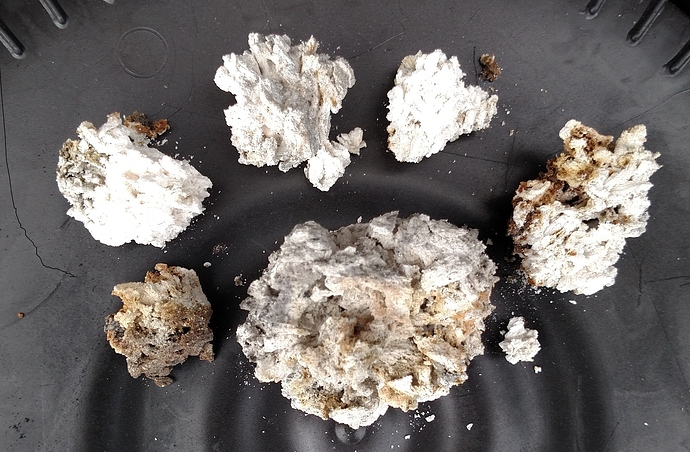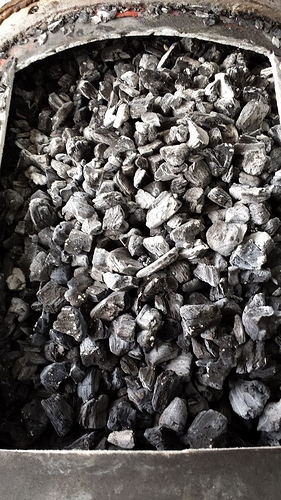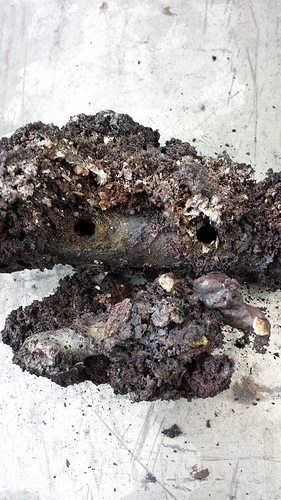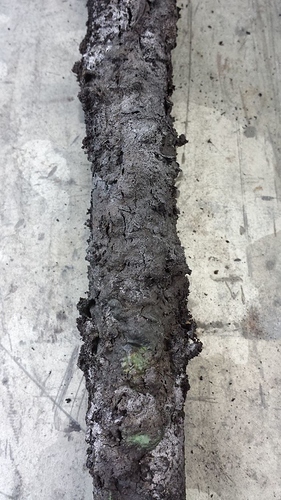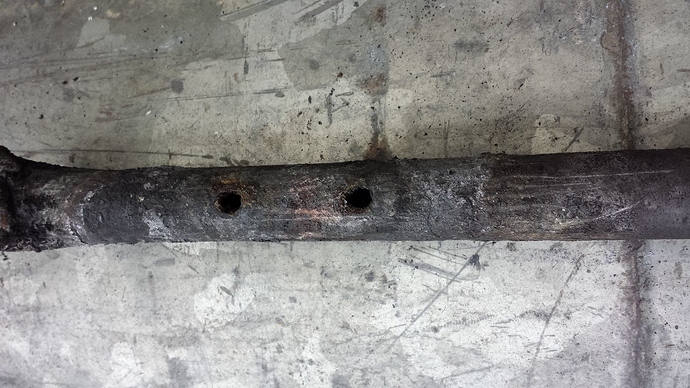l was thinkin about that when building the nozzle for my Seat. That is the reason l went with such a big diametar abd thick wall. The thicknes allows the heat to be conducted in the lower partof the pipe and the big volune alows air to swirl inside longer, cooling it.
Bruce got it eaven better with the copper pipe sticking out of the gasifier where they can radiate in ambient air.
I allso agree on the cheramic nozzle absorvation. Cheramic is a poor heat conductor. Hot on the tip and cool on the base, it just has to crack. I used your fuse type nozzle on mi moped when l noticed that phenimenom. The water drip allso wasnt friendly to it…
Yesterday I couldn’t start my engines on charcoal , no matter what I did , all ok on petrol though ,
so a while ago I did a blow test on all seals with air and soapy water , all good , so that only leaves one thing left , so laying the tank over on its side I opened up and took a look at the nozzle …
It was huge , I had one massive clinker build up all around the nozzle , and as soon as I tried to take the nozzle out it all just came away in my hand , including the nozzle that just crumbled away under a little pressure from my hands , I guess that’s the one bad thing about mixing refractory cement willy nilly , you have to make the mix as dry as possible and vibrate and compress it as tightly into the mould as you can .
Anyway no big deal just means that nozzle lasted around 45 days of running and only the past week and a bit on a water drip , so I still got a good enough run out of it .
I have replaced the stainless steel tube and drilled out the holes to 9mm and shall fire it up again in a little while and see how well that will last , in the mean time I have found some lovely thick walled mild steel pipe with a wall thickness of 3/4 of a inch , so I shall blank off the end and work out hole sizes once I have a better idea from running this stainless tube .
Dave
Hi guys, I’ve been following this nozzle talk and like the idea of the slot. The nozzle in the following picture is one inch pipe made from stainless steel. It screws into the nipple inside of the Simple-fire. The slot is 3/8 inches wide and four inches long. The rod next to it is designed to be run into the nozzle and clean any ash build up while the nozzle is in use. A fluid drip also helps cool the nozzle and increase the richness of the chargas. Any ash that falls into the nozzle is cleaned out using a piece of 3/4 inch conduit. The conduit is pushed into the nozzle and the ash is scooped up by it and removed. Shown above the new nozzle is a straight stainless steel nozzle that has been used several times.
Gary in PA
Quick update , stainless pipe is up and running , almost no noticeable difference to running on petrol at all once the water drip is on at 1 drip every 2 seconds I am getting the full 30 amps @ 24 volts from this tiny 87cc generator ,
Starting was very easy just start the fan and let a few pieces of charcoal get sucked up the pipe and then hit it with the gas gun and away it went , the water drips onto the pipe and runs towards the 9mm holes up the tube , but before it gets there its already steam and away it goes up through the holes .
Be interesting to see how your slotted pipe goes Gary , what engine do you plan on running with it ? .
Dave
Hi Dave, I agree with letting the water (or oil) just drip into the nozzle. The heat in there will vaporize it and also help cool the nozzle, To that end, I’ve given the air inlet a 5 degree or so tip downward to make sure the fluid flows down the nozzle and not out on the ground, The nozzle I showed should run your small engine up to a 450cc, engine,
Gary in PA
Based on Kristijan’s nozzle this 1 1/4 inch tube with .281" wall looks promising as a double inlet tuyere. The combined area of the two open ends is very close to the area of a 1" ID. $36 post paid for a 24 inch piece, more pieces saves on shipping cost.
http://www.ebay.com/itm/181188321765?_trksid=p2055119.m1438.l2649&ssPageName=STRK%3AMEBIDX%3AIT

Hi Bruce , i guess you cant moan at that price as I am sure they will last a long long time .
The stainless tube I put back into my gasifier is still up and running ok , I have not had a chance to open up the tank and take a look inside yet , but its still making gas so that’s all that matters right now , total run time so far must be around 64 hours .
Last week I bought 3 suitcase 3.5kva inverter generators all not working from a dealer on ebay and managed to get 2 of them up and running ,and also onto charcoal gas, they are running the Power Jack battery charger on the inverter and loading 50 amps into the batteries when flat , but if I run them with no water drip the engine hunts and cannot keep up the power , soon as there is a water drip the engine smooths out and I get a constant output of power .
Dave
Your run times are the best and your experience helps keep us all confident in this technology. I can hardly wait to see how long your’s and Gary’s SS nozzle’s last.
Besides giving two ways for heat to migrate away from the hot zone, a double ended tuyere allows water to flow out if the drip is accidentally left on. This happened to me. Hopefully I will get the MG back on the road soon and start logging some miles on my copper nozzle.
Nozzle Report
I happened to have the gasifier apart yesterday, so I snapped a picture of the nozzle.
This is the almumina ceramic tube coated with about 1/4" of refractory cement.
It only has about 2-3 hours of run-time on it. So far, it is showing no damage.
There is a slag spur building up on one side. It seems pretty firmly attached. Since it isn’t blocking the air flow, I decided to leave it rather than risk cracking the nozzle when removing it.
This is the first time I have used this particular design. I don’t know if it is a coincidence, or something to do with a change in the chemistry, but I had some strange white slag or ash blobs building up in the nozzle area that I had not observed before.
This stuff crumbles to a fine white powder under finger pressure.
Silica ash maybe? I have seen this also.
Ditto. I would speculate it protects the nozzle…
most likely its hydrogen sulfide, depending how it tastes of course 
since even normal air contains an certain amount of water, hydrogen is formed and mixed with your chargas.
at the maximal level of pulling gas from your gasifier / nozzle setup and with a higher humidity in the air, this phenomen will occur more or less. ( also has to do with the sulphur content from the wood used for the charcoal )
At higher temperatures, the sulfide will react in / with the minerals from the charcoal to form those crystals.
At lower temperatures it might be visible as a white deposite on your flaring tube, or as in my case, on the cooking burner.
To prevent that to much H2S will enter your engine, install some fine steelwool in your filterset, the H2S, if any, will corrode the steelwool and this corrosion will neutralizes the sulfide
Koen - Thanks for the info. I am going to guess that you are correct. Since I switched to the new generator setup, I am not using any exhaust gas to moderate the reaction. Also, the summers here are very humid.
So, that makes sense.
PS: Are you crazy? I’m not tasting that stuff.
Yesterdays run saw my little inverter generator hunting a fair bit and not making the power it had been since i started running it last weekend , so decided it was time to check out the stainless steel tube/nozzle as I go through the system looking for why I have weak gas .
The run time since I put it back in is around 68 hours , but I had also used it before although I cannot remember how long for so a round figure of 80 hours will do as a reference for my benefit .
The pictures show a large clinker build up around the 2 holes some of it broke away when I took the tube out and also shows a lot of white powder on the charcoal when I opened up the hatch , I know its just dust, as the back of the hatch was covered in it , but the wind just blew it off when I stood it up against the side of the tank before I could take a photo of it .
There seems to be a little oxidation of the stainless tube , but not enough to scrap it off just yet , I shall give it a much better clean later and replace it and run it till destruction , but at a guess I think it should be good for at least 200 hours looking at how worn it is so far .
Only dust around the hatch area no where else , I have tested for air leaks around the door many times ,but always seems well sealed . any idea’s ?
This is the underside of the tube and no clicker build up here , but a scale stuck to the tube that flaked off when hit .
once the clickers are cleaned off it looks pretty good , and should last at least the same again if not more .
I don’t think the nozzle will be causing the hunting problem on the generator , so filter drum is next on my list .
Dave
Hi Koen
is it better to use steel wool or of stainless steel wool?
Hi Thierry,
Only steel wool, not stainless.
Dave,
Looking good! 200 hours sounds pretty economical. Thanks for the pics.
Hi Kistijan:
I live in a developing country and will try to develop an easy to make and foolproof to handle charcoal gasifier for a motor vehicle. After doing my experience, my intention is to post a free, online design for the people. No business involved.
It seem to me that your charcoal gasifier is very simple to make and hopefully no tar involved.
So far what I got is that: the charcoal size you use is between 3-10mm; injecting 4l/100km you got a speed increased from 60 mph up to 70 mph at 2850rpm?; that your engine is Seat 1000 cc; the gasifier nozzle is special steel, interior diam seem to be between 32 - 50mm, ext diam seem to be between 44 - 62mm with four 10mm diam holes apart 100 mm between each hole…that is about all what I have from you charcoal gasifier…
When ever you may have a chance I will greately appreciate if you can give more specifications/sketch on your gasifier, ash separator, cooling and wg-air mixer.
“Your contribution to a better world of clean fuel” will thank you!
B.R.
Eddy
Since my copper tuyere/nozzle is holding up well in my MGB, I have decided to push the envelope with an aluminum nozzle. I am using 1-1/2" OD, 3/4" ID X 24" drilled and tapped on each end to receive 3/4" NPT fittings. I have also drilled two 1/2" nozzle holes at a 45 degree angle 1" apart. The nozzle holes will face upward. I will be testing in a 15 gallon drum with about 6 inches of the aluminum sticking out either side.
Since aluminum is a good conductor like copper, I am wondering if this tubing with 3/8" thick walls can conduct enough heat away from the reaction area to prevent melting and catastrophic oxidation? I’m also curious to know if an aluminum oxide layer may form. Would this aluminum oxide add extra heat resistance? Water or EGR might help, but I’m going to let her rip with air coming in both ends at about 5" water column vacuum and see what happens.
For sealing, I’m using pipe caps with 1-1/2" holes made with a hole saw. The pipe nipples will be fastened to the drum with 1-1/2’ electrical lock nuts and sealed with high temp silicone. The pipe caps will be filled with silicone and tightened down to squeeze around the tube and seal.
So what do you think? Will the tube melt? Will it be corroded away by oxidation? Both? Neither?
The downside to this system if it works is that the tube will be very HOT outside of the reactor.
G’day Bruce , wow your trying your luck now that’s for sure !
Cant wait too how you get on as I have no idea how good or bad Aluminium tube will hold up to the kind of temps we produce .
Good luck
Dave

